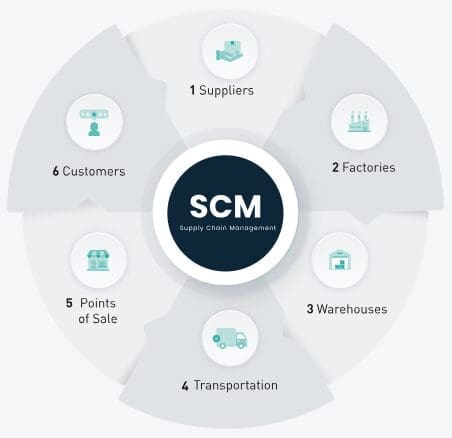Note: Today’s post is part of our “Editor’s Choice” series where we highlight recent posts published by our sponsors that provide supply chain insights and advice. This article comes from Carlos Díaz Madero, Subdirector Marketing at netLogistiK, and looks at the key trends that are transforming supply chain management.
In an ideal world, ensuring the immediate availability of products to customers would be simple, as demand would be easily predictable, all customers would be the same, there would be no special requirements, etc. However, reality is full of complex challenges and constant dilemmas. To help companies make sound decisions that favor their present and future financial health, it is essential to use advanced management techniques and methods, collectively known as supply chain management (SCM).
Supply chain management involves efficiently orchestrating suppliers, factories, warehouses, transportation modes, and points of sale so that products are produced and distributed in the right quantities, place, and time. The goal is to minimize total operating costs and meet customer service expectations.

In this context, it is crucial to be aware of the emerging trends transforming the supply chain management field. Below, we explore the three main trends in supply chain management that are helping companies become more agile, efficient, and customer-centric.
Customer-Centric Supply Chain
At the heart of every supply chain is the end customer. This customer pays the bills and has the power to make or break a business. Recognizing this fact and working tirelessly to improve customer satisfaction is what we call “customer centricity.”
Today, consumers can access various tools to select suppliers and retailers that offer the best prices, superior services, and delivery options tailored to their lifestyles. The modern consumer seeks immediate availability, fast delivery promises, product and service customization, and competitive prices. This new dynamic has forced businesses to elevate their service levels to maintain customer loyalty and preference.
However, improving a service offering generally involves increasing operating costs. Since consumers can easily compare prices, passing these additional costs onto customers can jeopardize sales, forcing businesses to reduce their profit margins. Leading companies have reinvented their supply chains and management processes to regain profitability and adapt to customer demands. For example, the emergence of new storage and distribution models, such as dark stores, allows for record-speed order deliveries at a fraction of the cost compared to traditional methods.
Moreover, the digitalization of the supply chain has granted greater visibility to both companies and customers. Digital platforms enable customers to track their orders in real-time, receive updates on the status of their deliveries, and make special requests. Implementing mobile applications and using chatbots and virtual assistants enhance the customer experience by providing immediate and personalized attention. This transparency improves the customer experience and allows companies to respond more efficiently to changing demands and expectations, thus optimizing their operations and maintaining high satisfaction levels.
“There is only one boss. The customer. And he can fire everybody in the company, from the chairman down, simply by spending his money somewhere else.”
– Sam Walton, CEO, Walmart.
To read the full article, click HERE.




















